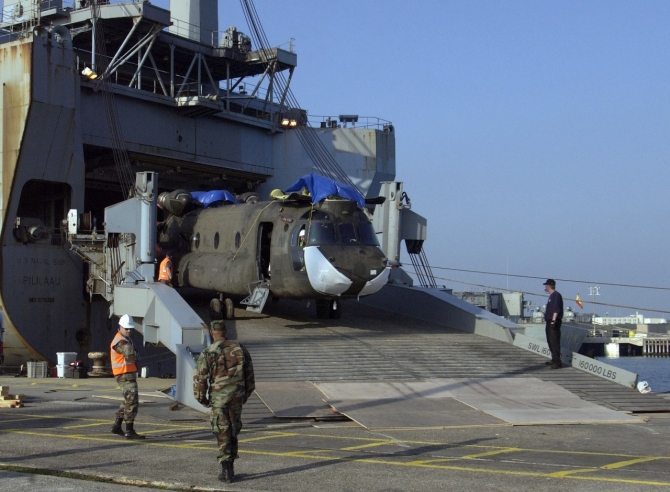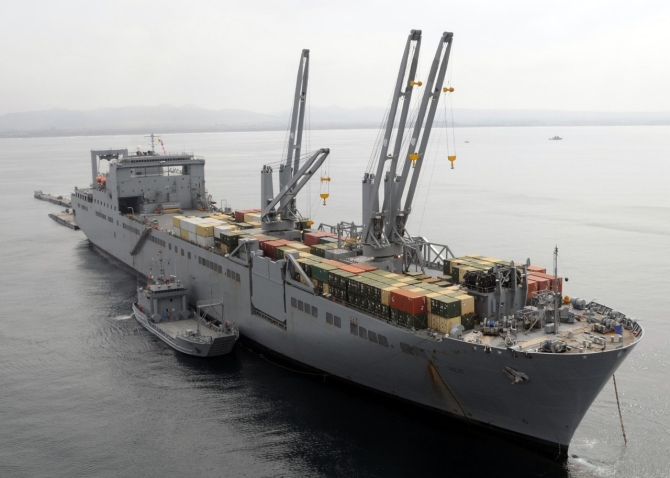Pililaau (T-AKR-304)
2000–
First U.S. Navy ship named in honor of Private First Class Herbert Kailieha Pililaau who was an American combat soldier killed in action during the Korean War. He was posthumously awarded the Medal of Honor for his actions near Pia-ri, Korea on 17 September 1951.
Herbert Kailieha Pililaau was born on 10 October 1928 in Waianae, Territory of Hawaii. He graduated from Waipahu High School in 1948 and was drafted in to the U.S. Army in 1951.
Pililaau completed basic training at Fort Shafter, Hi., was deployed to Korea in March 1951 and served as a private first class with Company C, 23rd Infantry Regiment, 2nd Infantry Division. Volunteering to be his squad's automatic rifleman, he carried a Browning Automatic Rifle (BAR). From 18 August to 5 September he fought in the Battle of Bloody Ridge, in which the 2nd Infantry Division attacked and captured a ridge in east central Korea. Their next objective was a hill to the north near Pia-ri which would come to be known as Heartbreak Ridge.
On 17 September 1951, Company C along with two others was tasked with capturing Hill 931, one of Heartbreak Ridge's two identifiable peaks from North Korean forces. When Company C's attack stalled on a ridgeline which ran south from the main peak, Pililaau's platoon set up a defensive perimeter ahead of the rest of the company. With the help of artillery, mortar and heavy machine gun support, the platoon held off a series of probing assaults which began in the mid-afternoon. Near 1000, two battalions of the 13th Infantry Regiment, 6th Division, Korean People's Army, began a concerted attack on the position. With North Korean artillery striking close by and ammunition running low, received permission to withdraw and rejoin the main body of the company as quickly as possible. Pililaau’s squad was ordered to stay back momentarily in order to cover the retreat. After exhausting the ammunition for his BAR, he began throwing hand grenades until those were also gone. Pililaau then began throwing rocks at the attackers before charging at them with his trench knife in one hand and a clenched fist with the other until he was finally overcome and mortally wounded. When his platoon retook the position the following day they found more than 40 enemy dead around his body.
Pililaau was interred at the National Memorial Cemetery of the Pacific in Honolulu on 26 February 1952.
(T-AKR-304: displacement 62,644; length 950'; beam 106'; draft 35'; speed 24 knots; complement 26 civilian (up to 45) up to 50 active duty; class Bob Hope)
Pililaau (T-AKR-304) was laid down on 29 June 1998 at New Orleans, La., by Avondale Shipyard, Inc.; and launched on 29 January 2000. She entered non-commissioned U.S. Navy service with the Military Sealift Command (MSC) with a primarily civilian crew on 24 July 2001. A non-combatant Large, Medium-Speed, Roll-on/Roll-off (LMSR) vessel, Pililaau and other ships of her class are used to preposition tanks, trucks, various wheeled vehicles and supplies needed to support an army heavy brigade. She is assigned to the MSC Atlantic surge force and is maintained in Ready Operational Status 4.

During mobilization for the continuing global war on terrorism, the MSC surge fleet of LMSRs and fast sealift ships delivered 10.7 million square feet of cargo. This was approximately forty percent of the total dry cargo carried by all MSC government-owned and chartered ships during fiscal year 2004.
The Surge Project fleet includes 11 LMSRs and eight fast sealift ships that are all maintained in a four-day reduced operating status at various U.S. East and Gulf Coast ports. The LMSRs are especially suited for transporting heavy or bulky unit equipment such as tanks, large wheeled vehicles and helicopters.
Surge Project LMSRs were one of MSCs biggest success stories during the 2004 deployment phase of the Operation Iraqi Freedom troop and equipment rotation. They were activated within three days and maintained an average speed of more than 17 knots throughout the deployment. With a 300,000 square foot capacity per ship, the 11 Surge Project LMSRs delivered more than 7.6 million square feet of cargo in 39 voyages. This averaged 194,540 square feet per ship per voyage. One LMSR effectively replaced six commercial ships chartered during Operation Desert Storm in 1990-91.

Detailed history pending.
Paul J. Marcello
23 December 2015


